Artículo
Lipid, fatty acid and protein utilization during lecithotrophic larval development of Lithodes santolla (Molina) and Paralomis granulosa (Jacquinot)
Kattner, Gerhard; Graeve, Martin; Calcagno, Javier Ángel ; Lovrich, Gustavo Alejandro
; Lovrich, Gustavo Alejandro ; Thatje, Sven; Anger, Klaus
; Thatje, Sven; Anger, Klaus
 ; Lovrich, Gustavo Alejandro
; Lovrich, Gustavo Alejandro ; Thatje, Sven; Anger, Klaus
; Thatje, Sven; Anger, Klaus
Fecha de publicación:
07/2003
Editorial:
Elsevier Science
Revista:
Journal of Experimental Marine Biology and Ecology
ISSN:
0022-0981
Idioma:
Inglés
Tipo de recurso:
Artículo publicado
Clasificación temática:
Resumen
During the larval development of the subantarctic king crab, Lithodes santolla, and stone crab, Paralomis granulosa, we compared changes in the carbon, fatty acid and protein contents of larvae reared under constant conditions from hatching to metamorphosis, either in presence or absence of food (Artemia spp. nauplii). In both species the feeding condition had no influence on any of the chemical parameters studied, indicating a fully lecithotrophic (i.e. non-feeding) mode of development from hatching of the first zoea to metamorphosis of the late megalopa. Dry mass and carbon contents at hatching were similar in the larvae of both species, but L. santolla contained initially higher total amounts of fatty acids and protein than P. granulosa. Both species utilized considerable portions of their total fatty acid pool which decreased logarithmically throughout the time of development. At metamorphosis, it was almost exhausted in P. granulosa, while L. santolla had consumed only about 60%. Protein utilization, in contrast, was higher in L. santolla (40%) than in P. granulosa (20%). Triacylglycerol was the principal storage lipid in both species, accounting initially for about 75% of the lipid fraction; it was strongly utilized during larval development. Phospholipid constituted the second largest lipid class; it also decreased in P. granulosa, but to a lesser extent in L. santolla. The major fatty acids of both species were 18:1(n - 9), 20:5(n - 3) and 16:0 as well as, in lower proportions, 18:1(n - 7), 22:6(n - 3), 16:1(n - 7) and 18:0. Monounsaturated fatty acids represented the dominant group in L. santolla, whereas P. granulosa contained similar amounts of mono- and polyunsaturated fatty acids. In L. santolla, monounsaturated fatty acids, especially 16:1(n - 7), were preferentially utilized as compared to polyunsaturates. Due to a particularly strong lipid utilization in P. granulosa, all individual fatty acids were largely depleted at metamorphosis, showing similar extents of consumption. L. santolla had higher initial lipid and protein stores that seem to be used more economically as compared to P. granulosa. © 2003 Elsevier Science B.V. All rights reserved.
Palabras clave:
FATTY ACIDS
,
LARVAL DEVELOPMENT
,
LECITHOTROPHY
,
LIPIDS
,
LITHODIDAE
,
PROTEIN
Archivos asociados
Licencia
Identificadores
Colecciones
Articulos(CADIC)
Articulos de CENTRO AUSTRAL DE INVESTIGACIONES CIENTIFICAS
Articulos de CENTRO AUSTRAL DE INVESTIGACIONES CIENTIFICAS
Citación
Kattner, Gerhard; Graeve, Martin; Calcagno, Javier Ángel; Lovrich, Gustavo Alejandro; Thatje, Sven; et al.; Lipid, fatty acid and protein utilization during lecithotrophic larval development of Lithodes santolla (Molina) and Paralomis granulosa (Jacquinot); Elsevier Science; Journal of Experimental Marine Biology and Ecology; 292; 1; 7-2003; 61-74
Compartir
Altmétricas



